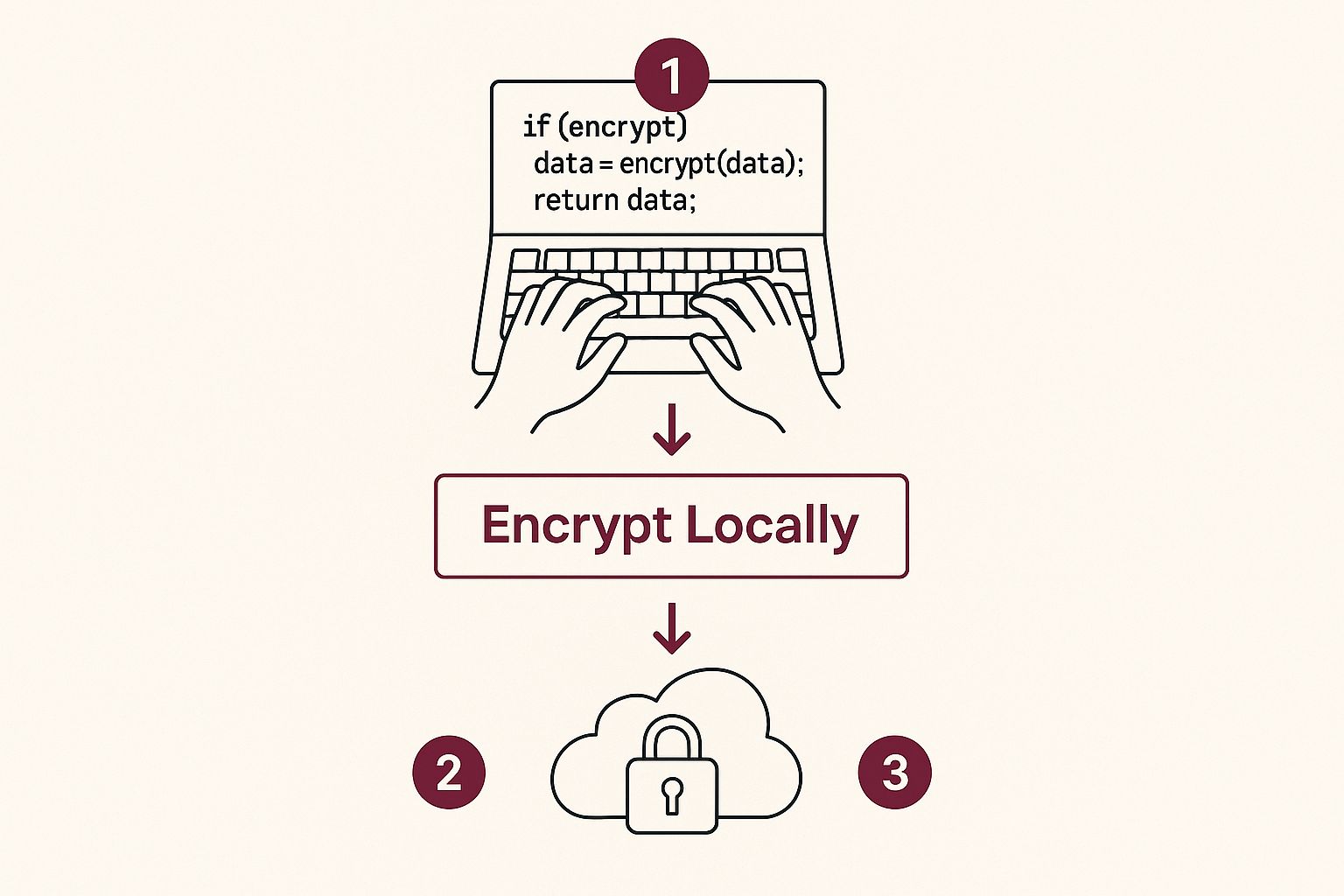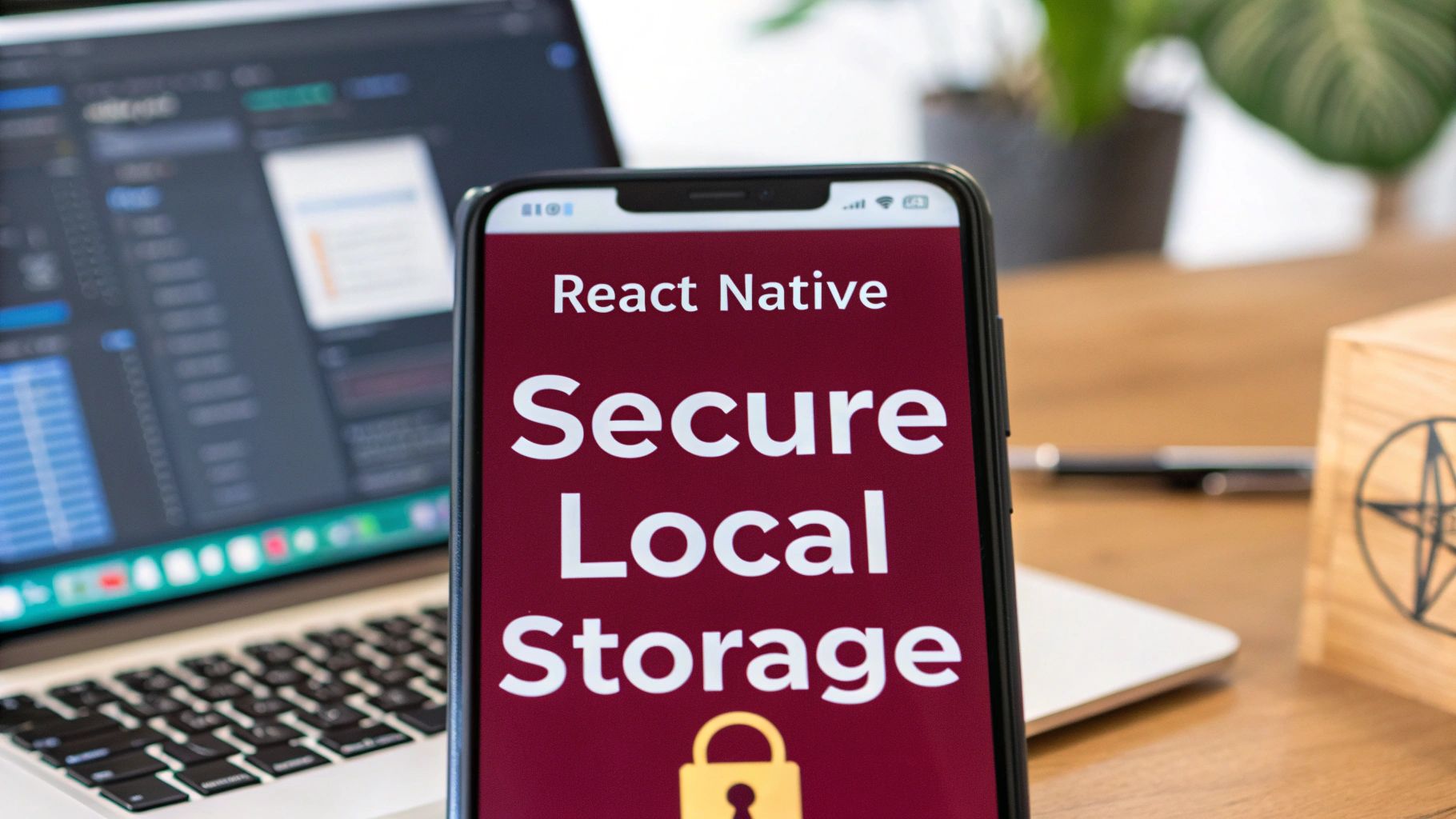If you’re storing sensitive data in AsyncStorage, you’re playing with fire. It’s the equivalent of writing down your passwords on a sticky note and leaving it on your desk—it’s just plain text, wide open for anyone to grab. Any attacker who gets their hands on a compromised device can easily pull user tokens, API keys, or personal info.
The Hidden Dangers of Standard Local Storage
When you’re building a React Native app, it’s easy to fall back on AsyncStorage for simple key-value storage. It’s convenient for things like user preferences or theme settings, but it becomes a massive security hole the moment you put anything sensitive in it. The real issue is that AsyncStorage just dumps its data into an unencrypted file right on the device’s storage.
This complete lack of encryption leaves your app and your users vulnerable to a whole host of attacks. Before we can build a secure app, we have to understand what we’re up against.
How Unencrypted Storage Leaves You Exposed
The most obvious threat is physical access. If a user’s phone is lost or stolen, it’s trivial for someone with basic tools to browse the device’s file system and read everything you’ve saved. This is especially dangerous for authentication tokens, which could give an attacker a free pass to impersonate the user and hijack their account.
Another major problem is rooted (on Android) or jailbroken (on iOS) devices. These modified operating systems bypass the standard security sandboxing, meaning one malicious app could potentially snoop around and read the data files of other apps, including yours.
Think of it this way: anything you put in
AsyncStoragemight as well be public. If you wouldn’t hardcode a secret into your public source code, you definitely shouldn’t be storing it in unencrypted local storage.
The demand for better security is why the global secure data storage market is blowing up. Businesses are finally waking up to the fact that protecting user data isn’t just a feature—it’s a necessity. You can see just how fast this space is growing by checking out the latest secure storage market size and trends.
So, What’s at Stake for Your App?
Putting any of the following in AsyncStorage is just asking for trouble:
- Authentication Tokens (JWTs): If these leak, an attacker has full control of a user’s session. Game over.
- API Keys: Leaked keys can lead to devastating abuse of your backend services, running up huge bills or causing a major data breach.
- Personally Identifiable Information (PII): Storing names, emails, or financial details insecurely is a recipe for serious privacy violations and potential legal nightmares.
Getting this right isn’t optional anymore. To build a solid foundation, every developer should be familiar with modern mobile app security standards. It’s the baseline for building apps that users can actually trust.
Choosing Your Secure Storage Library

Alright, now that we’ve established why leaving data exposed is a bad idea, let’s get into the tools that will actually protect it. Fortunately, the React Native community has built some fantastic libraries for secure local storage. These tools don’t reinvent the wheel; instead, they plug directly into the native platform’s security hardware.
The best libraries tap into the iOS Keychain and Android Keystore. Think of these as hardware-backed secure vaults on the device itself. This is a far cry from just encrypting a file on your own. Here, the operating system manages the cryptographic keys in a highly protected environment, which is exactly what you want.
Top Libraries for Secure Local Storage
Let’s look at the main players. I’m not just going to list features; we’ll talk about what it’s actually like to work with them.
-
react-native-keychain: This library is a specialist. It’s laser-focused on one thing: securely storing credentials like usernames, passwords, and auth tokens. It has a dead-simple API for this exact purpose and has been battle-tested for years. If you just need to save a token, this is a solid, reliable choice. -
react-native-encrypted-storage: If you need something more flexible that feels likeAsyncStorage, this is it. It gives you that familiarsetItemandgetIteminterface but handles all the encryption and decryption for you, using the native Keychain and Keystore. This makes it a perfect drop-in replacement forAsyncStoragewhen you’re dealing with any sensitive string data—user profiles, cached API responses, you name it.
When you’re picking a library, do yourself a favor and check its recent commit history and open issues on GitHub. An actively maintained package is a good sign it will keep up with new React Native versions and patch security issues quickly.
Making the Right Choice for Your App
So, which one should you actually use? It really boils down to what you’re storing.
If your app’s only secret is a user’s JWT or API token, react-native-keychain is a lean and effective tool for the job. It’s specialized, and it excels at what it does.
On the other hand, if your app needs to store a bunch of different sensitive things—user preferences, offline data, or any personally identifiable information (PII)—then react-native-encrypted-storage is a much more versatile and future-proof solution. Its AsyncStorage-like API makes it incredibly easy to adopt. The concepts here also tie into bigger security strategies, and if you’re interested, you can learn more about how to implement end-to-end encryption to build an even more robust security model.
Ultimately, both libraries are a massive security upgrade over storing anything in plain text. For most projects I work on, react-native-encrypted-storage tends to be the winner simply because of its flexibility. It gives you a secure foundation that can easily adapt as your app grows.
Getting Your Hands Dirty: Implementing Encrypted Storage
Alright, enough theory. Let’s get down to actually putting encrypted storage into your React Native app. We’ve settled on react-native-encrypted-storage for its solid, cross-platform support, and now it’s time to wire it up. Getting this right from the start will save you a world of pain later.
First things first, you need to add the library to your project. This is a simple command you’ve probably run a thousand times.
Pull it in with npm
npm install react-native-encrypted-storage
Or if you’re a yarn fan
yarn add react-native-encrypted-storage
Once that’s done, you have to link the native bits. For iOS, you’ll jump into the ios directory and run pod install to make sure Xcode knows about the new native code. Android is usually smart enough to handle this on its own these days, but it never hurts to double-check that everything is linked up correctly during your next build.
With just those few steps, you’ve bridged the gap between your JavaScript code and the device’s native encryption capabilities. You’re now ready to build a truly secure local storage solution. The whole point is to make sure sensitive data gets scrambled before it ever hits the disk, as you can see here.

This diagram really nails the core idea: transforming private info into gibberish that’s useless to anyone without the key.
Writing and Reading Data Securely
With the library installed, we can get to the fun part. The API was cleverly designed to mimic AsyncStorage, which is a huge plus if you’re migrating an existing app or are just used to that workflow.
Let’s walk through a common real-world scenario: storing a user’s authentication token after they log in.
import EncryptedStorage from ‘react-native-encrypted-storage’;
// A function to securely save the user’s session data async function saveUserSession(token) { try { await EncryptedStorage.setItem( ‘user_session’, JSON.stringify({ authToken: token, createdAt: Date.now(), }) ); // If we get here, the token is safely stored and encrypted! } catch (error) { // Something went wrong on the native side. Log it! console.error(‘Failed to save the user session securely:’, error); } }
// A function to retrieve the session when the app starts async function retrieveUserSession() { try { const session = await EncryptedStorage.getItem(‘user_session’);
if (session) {
// Found it! Now we can parse it and use the data.
return JSON.parse(session);
}
// No session found, which is a valid scenario.
return null;} catch (error) { // Something went wrong trying to read from storage. console.error(‘Failed to retrieve the user session:’, error); } }
You’ll notice I’m using async/await and wrapping everything in try...catch blocks. This isn’t just for show. Since you’re calling down to native device modules, these operations are asynchronous and can fail for various reasons. Solid error handling isn’t just a good idea—it’s absolutely critical for building a stable app.
A Cleaner Approach: Centralizing Your Storage Logic
Now, you could sprinkle these EncryptedStorage calls all over your components, but please don’t. That’s a direct path to messy, hard-to-maintain code. A much smarter way to handle this is by creating a dedicated service or a set of custom hooks for all your storage operations. This keeps your UI clean and your storage logic all in one place.
Here are a few tips I’ve learned for creating a robust storage module:
- Define Your Keys: Create a single file for all your storage keys (e.g.,
'user_session'). This tiny step prevents typos from causing nasty bugs that are a pain to track down. - Expect
null: Always, always check if a retrieved value isnullbefore you try toJSON.parse()it. - Plan for Logout: Write a specific
clearUserSessionfunction that you can call when a user logs out to securely remove their credentials.
This strategy fits right in with broader security best practices. If you want to go deeper, this guide on 7 mobile app encryption best practices is an excellent resource. And while we’re talking about security, it’s worth noting that these principles apply to web development, too. When building complex applications, many teams turn to expert Next.js development services to ensure security is baked in from the start.
Mastering Key Management and User Sessions
Putting an encrypted storage library into your app is a fantastic start, but the real work begins with how you handle the keys and user sessions. Think about it: your encryption is only as good as the key that locks it.
The good news is that a library like react-native-encrypted-storage takes care of the heaviest lifting. It doesn’t just create a key and leave it exposed. Instead, it taps into the device’s own hardware-backed security modules—the Keychain for iOS and the Keystore for Android.
These aren’t just bits of software; they are secure, isolated environments built right into the hardware. They’re specifically designed to keep cryptographic keys safe from the main operating system. This makes it incredibly tough for an attacker to get their hands on the keys, even if the device is rooted.
Securely Managing User Sessions
One of the most common reasons we need secure local storage is to manage user authentication tokens. We want to keep users logged in for a smooth experience, but we can’t compromise on security.
So, when a user logs in, you’ll stash their session token (like a JWT) in encrypted storage. But the real question is, what do you do when that token expires?
- Use a Refresh Token Flow: Don’t just store the access token. Store a longer-lived refresh token alongside it. When the main access token expires, your app can use the refresh token to silently fetch a new one from your server, all without interrupting the user.
- Wipe Data on Logout (Seriously): This is absolutely critical. When a user explicitly logs out, your app must remove all their sensitive data from storage. This means all tokens, cached user details—everything. Skipping this step is like leaving the ghost of a user’s session behind on the device.
Strong key management often involves borrowing ideas from other high-stakes domains. For instance, learning the safest way to store cryptocurrency can teach you a lot about securing seed phrases and using hardware wallets—principles that translate well to general app security.
Pairing a solid refresh token strategy with a rigorous logout process creates an authentication flow that’s both resilient and secure. If you want to go deeper on this topic, our guide on implementing authentication in React Native walks through more detailed patterns and code examples.
A Look at Decentralized Storage
Beyond the traditional client-server model, it’s worth keeping an eye on decentralized storage. This approach uses a network of distributed nodes to store data, which makes it naturally resistant to censorship and single points of failure.
Valued at USD 622.9 million in 2024, this market is poised for serious growth. It offers a compelling, privacy-focused alternative to centralized cloud services, especially in areas with strict data sovereignty laws. You can read up on this trend in the latest decentralized storage market analysis from GMI Insights. It represents a fundamental shift in how we think about data ownership and security.
Secure Storage and Over-The-Air Updates

Shipping your app is just the beginning. The real test of your security strategy comes later, specifically when you start pushing over-the-air (OTA) updates. This is where your approach to secure local storage can either save the day or cause a major headache.
Services like CodePushGo are fantastic because they let you send JavaScript updates directly to your users, skipping the whole app store review saga. It’s a game-changer for deploying quick fixes. But this speed introduces a new variable: what happens to your encrypted data when the app’s logic suddenly changes?
An OTA update swaps out your app’s code, but it leaves the user’s securely stored data untouched. This is both a blessing and a curse. Users don’t get logged out, which is great. But what if your update messes with the data structure or, worse, the encryption logic itself?
Navigating OTA Updates and Encrypted Data
A poorly managed update can be a catastrophe. I’ve seen it happen: a team pushes a new version that expects a slightly different format for the user session object. The app tries to read the old, now-incompatible data from secure storage, fails, and suddenly every single user is logged out. In the worst cases, the app just crashes on startup.
Here are a few of the classic traps you need to sidestep:
- Data Migration Failures: If you change the shape of your stored objects, you must ship migration logic with the update. This code needs to safely read the old format, transform it into the new one, and then re-encrypt and save it.
- Accidental Key Invalidation: This one’s rare but devastating. An update could, for instance, change a native dependency that affects how encryption keys are managed. This can make all existing stored data completely unreadable.
- Logic Mismatches: Your new code might make assumptions about the data that are no longer valid. This leads to those subtle, infuriating bugs that are a nightmare to track down.
Think of your user’s secure storage like a production database you can’t directly control. Your app’s code must always be backward-compatible with data stored by older versions, or you must provide a bulletproof migration path.
A Safe Workflow for OTA Deployments
So, how do you avoid these nightmares? With a disciplined testing process. Before you even think about pushing an update to everyone, deploy it to a staging channel in CodePushGo first.
Then, grab a physical device that’s running the current production version of your app and has real, encrypted data stored on it. Install the staging update on that device. This is the crucial step.
This simple check is the only way to confirm that your new code can correctly read and interact with the existing secure data. It ensures the transition is seamless, keeping the user experience both smooth and secure. For a more detailed look, our guide on how over-the-air updates for React Native can be managed effectively is a great resource.
Answering Your Secure Local Storage Questions
Whenever I dive into secure local storage with a development team, the same great questions and “what-if” scenarios always pop up. Getting these sorted out early on is crucial because it helps avoid common pitfalls that can accidentally weaken your app’s security.
Let’s walk through some of the most common questions I hear.
Keychain vs. Encrypted Storage
One of the first decisions you’ll face is which library to use. The two big players are react-native-keychain and react-native-encrypted-storage, and knowing the difference is key to making the right call.
Think of react-native-keychain as a specialist. It’s laser-focused on one job: securely storing credentials. If all you need is a safe place for a username and password or an auth token, its simple, dedicated API is perfect.
On the other hand, react-native-encrypted-storage is the general-purpose workhorse. It acts as a drop-in, encrypted replacement for AsyncStorage, ready to handle any string-based data you throw at it. Need to store JWTs, sensitive user preferences, or cached API data? This library offers the flexibility you need for a comprehensive secure local storage solution.
The most important thing to remember is that both libraries are tapping into the native, hardware-backed security of iOS Keychain and Android Keystore. You aren’t just encrypting a file on the disk; you’re handing the keys over to the most secure element of the device’s OS.
What About Security on a Compromised Device?
This leads directly to the million-dollar question: is the data still safe if a user’s device is rooted or jailbroken?
While these libraries make it exceptionally difficult for an attacker to get their hands on the encryption keys, no software solution is invincible when the underlying operating system has been compromised. An attacker with root access has the power to do things like hook into your app’s memory and intercept data as it’s being used.
That’s why secure storage should never be your only line of defense.
- Root & Jailbreak Detection: It’s a good practice to build detection mechanisms into your app. If you discover it’s running on a compromised device, you can take action, whether that’s limiting features or preventing the app from running altogether.
- Runtime Application Self-Protection (RASP): This is a more advanced layer that actively monitors your app for real-time attacks and can defend against them on the fly.
This kind of layered security is fundamental. Secure storage is just one piece of a much larger puzzle. To get a better handle on the big picture, it’s worth understanding what end-to-end encryption is and how those principles protect data both in transit and at rest.
Ready to ship updates as securely as you store data? CodePushGo provides end-to-end encrypted over-the-air updates for your React Native apps, ensuring your code is as protected as your users’ information. Streamline your releases and deploy fixes instantly at https://codepushgo.com.




